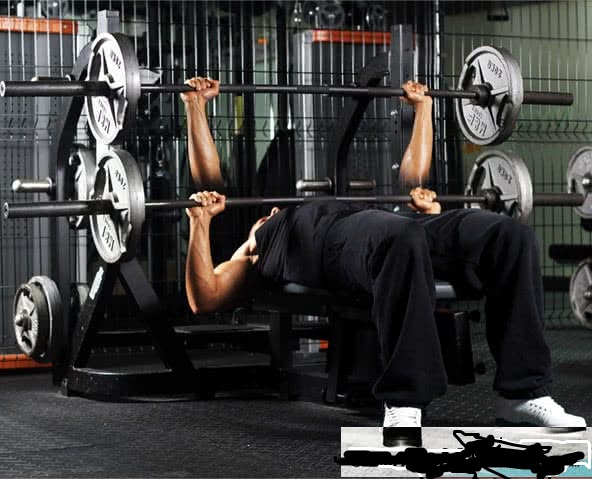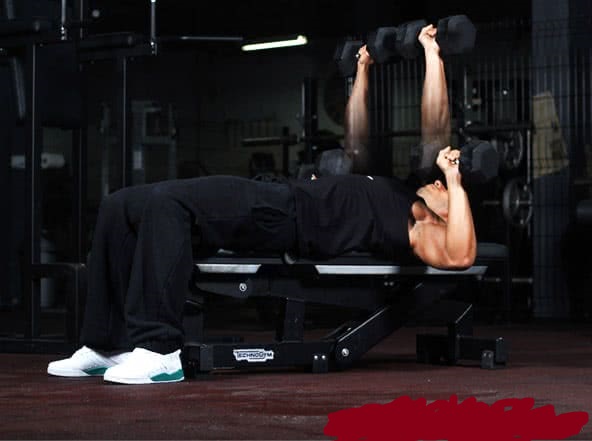
What is the bench press and why?
The bench press is the reference exercise for the musculation of the pectorals. This poly-articular exercise allows to muscle all the muscles of the chest and more particularly the pectoral major muscle. The bench press that is part of the three athletic strength movements is very effective in gaining muscle mass as it allows to work with heavy loads.
How to make the bench press?
Lying on a horizontal bench, the buttocks in contact with the bench, feet on the bench, on the ground or legs raised.
Take the bar, hands in pronation taking a distance greater than the width of the shoulders.
Inspire and lower the bar by controlling movement to the chest.
Develop by expiring at the end of the effort.
- 7 Training Tips
1 By performing the developed elbows along the body, you will concentrate work on the anterior beams of the deltoids.
2 To solicit the central part of the pecs, you only need to reduce the gap of the hands.
3 In order to apply the external part, it will be necessary, conversely, to increase the separation of the hands.
4 You can solicit the lower part of the pectorals by descending the bar on the chondro-costal edge of the thorax.
5 If you wish to apply the median beams, lower the bar on the center of the pectorals.
6 To apply the upper part, lower the bar on the sternal fork.
7 The realization of the movement legs raised or with the feet on the bench avoids hyper-lordosis which is conducive to lower back pain.

What are the mistakes to avoid the bench press?
Avoid lowering the bar too much at the top of the pectorals for two reasons.
First, it is a little more difficult to overload the chest muscles which, in fact, can develop loads much heavier than what allows this type of trajectory with the bar. The fundamental element of muscular development is thus lost.
Secondly, mechanically, your shoulders are under stress which could end up causing injury. The humerus (bone of the arm) and the scapula meet to form the scapulo-humeral articulation, the centerpiece of the shoulder, and the so-called "subacromial space" dampens the contact of these two bones. This space is occupied by many of the tendons and ligaments that stabilize the shoulder. If the arm is moved in such a way that the head of the humerus almost enters into forced contact with the scapula, this space is reduced and the risk of pinching in the shoulder is increased. This is exactly what happens when the elbows are brought back to the point that the bar reaches the top of the chest during the bench press.
What muscles are involved?
The developed bench presses the large pectorals as a whole, small pectorals, triceps, anterior deltoid, serratus and coraco-brachial.

This variant makes it possible to work the pectorals with a great amplitude. This movement is much more effective than the classic lying down to target the center of the chest. On the other hand, the bench press with dumbbells does not allow to take as heavy as with a bar.
How to do the bench press with dumbbells?
Lying on the back, head, shoulders and buttocks in contact with the horizontal bench. Keep legs slightly apart, knees bent at 90 ° and feet flat on the floor.
Hold a dumbbell in each hand with a pronation (palms from the hands to the feet), arms fully extended so that the loads touch directly over your head.
Inspire and hold your breath as the loads lower, elbows move laterally as the dumbbells move closer to the sidewalls.
Quickly change direction and develop loads until your arms are fully extended.
Exhale strongly as you pass the most difficult phase of the climb.
Take a break in the finish position, the dumbbells against each other, then repeat.
- 5 training tips
1 Since it is a little harder to balance dumbbells (especially if one arm is weaker than the other), you may have to take a total load a little less than a bar.
2 If you use very light loads, the respiratory pattern is of little importance. On the other hand, with heavy dumbbells or when the muscles are already tired, breathing becomes very important. By blocking the breath after the inspiration, the torso is stabilized, which is a firm support against which the muscles can contract. At expiration, the body relaxes and this rigidity of the chest is lost: it is therefore necessary to expire only when the pectorals do not contract to the maximum.
3 Some practitioners push against the floor with the feet to mount the pelvis during the development, especially if the loads are heavy. Nevertheless, this rise of the pelvis modifies the angle of the torso during the thrust, which involves the sternal portion of the pectorals, generally stronger than the clavicular portion. This low-back separation also accentuates the lumbar arch: if it is exaggerated and the work is heavy, there is a risk of injury.
4 The bench press with dumbbells can also be made with a neutral grip, the palms facing the torso. In this case, only the upper parts of the pectorals and the anterior deltoids are involved, the stress being increased on the triceps.
5 To accentuate the difficulty of the exercise: during the descent of the loads, exhale while arriving at the bottom, then pause while maintaining the muscular tension. Inhale deeply and exhale only once you have passed the delicate point of the developed. Also mark down time at the top, arms tight. Inhale again, block your breathing by lowering the loads and exhaling gradually as you approach the low position. Pause before starting again.